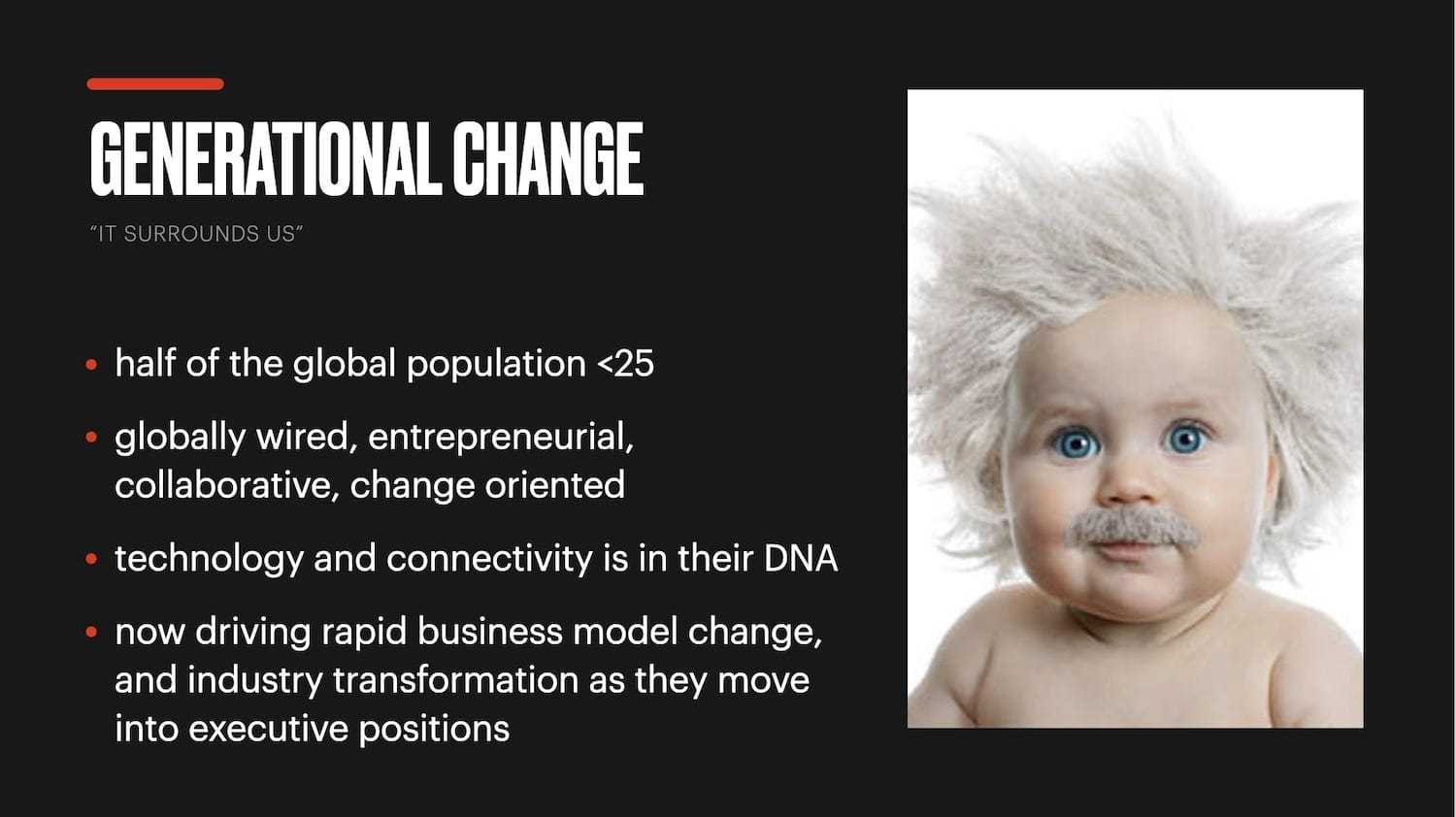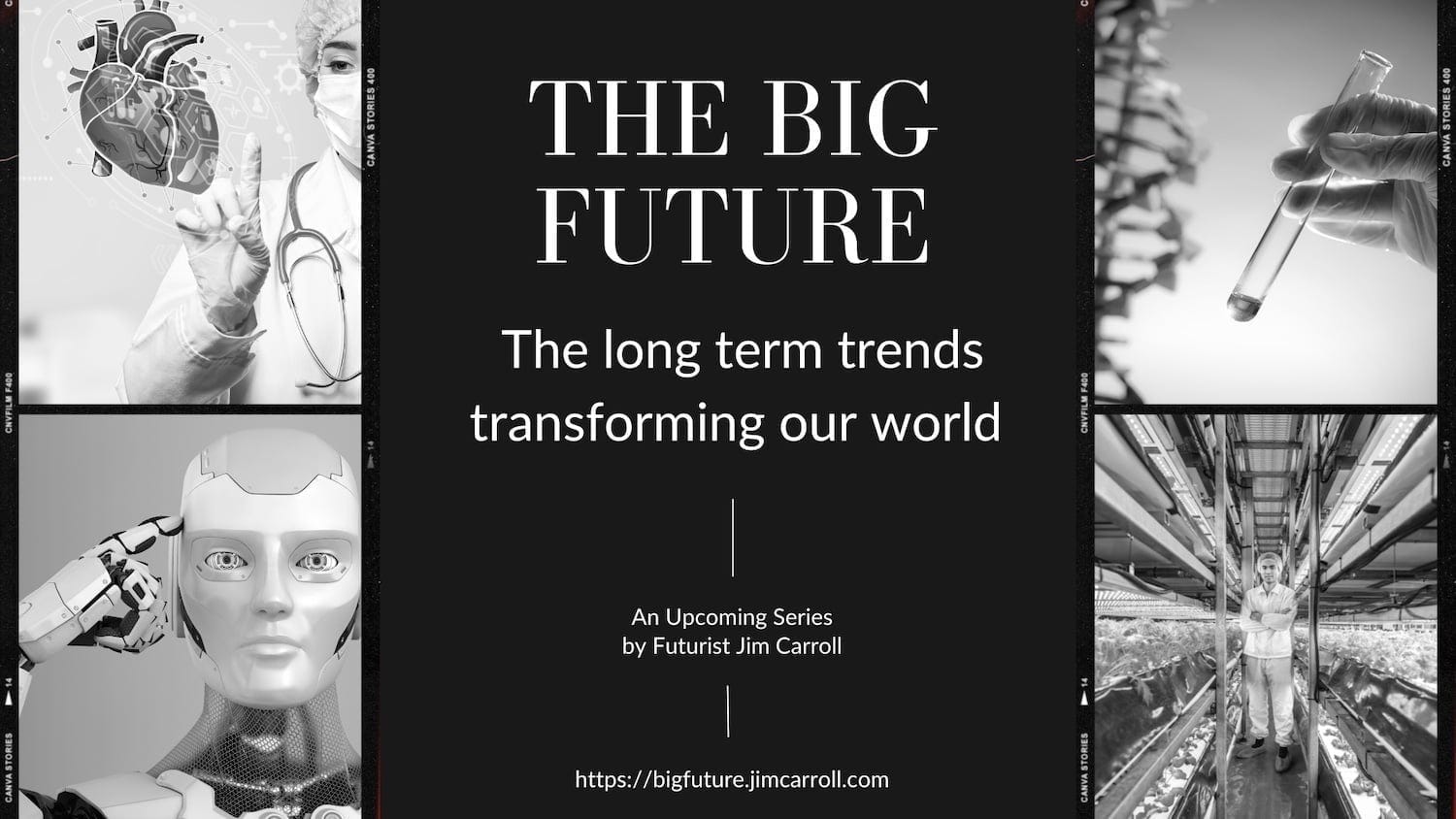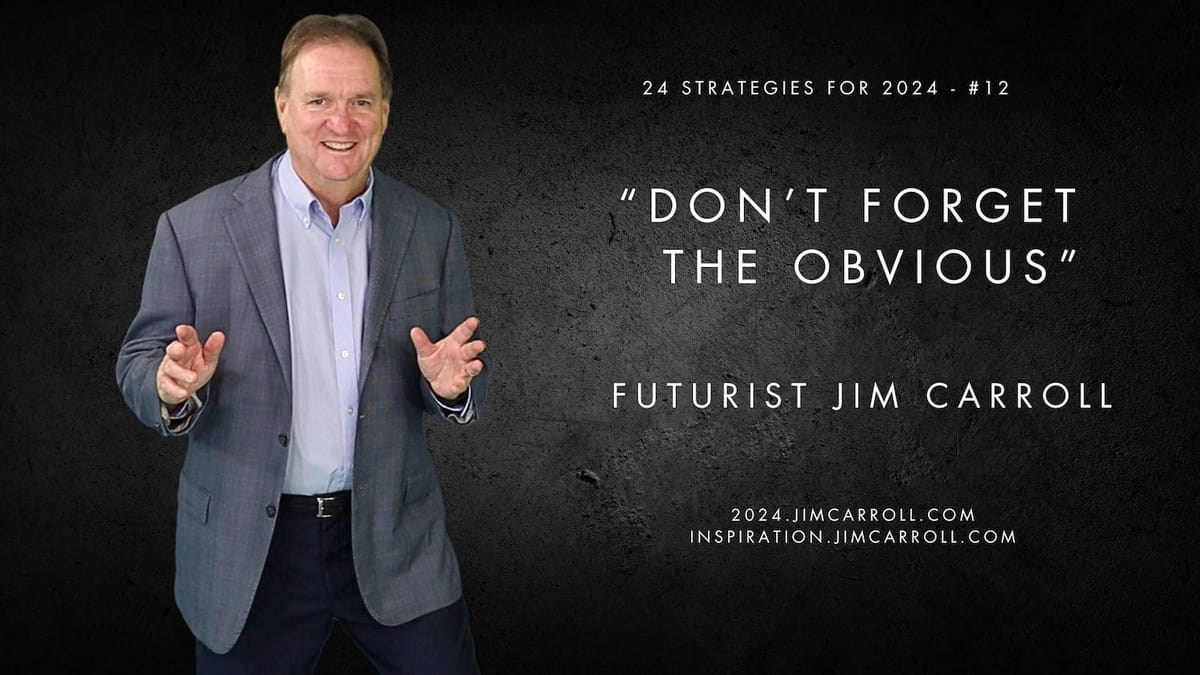Futurist Jim Carroll is running a series that began November 27, 2023, and will end on January 1, 2024 - '24 Strategies for 2024.' Rather than running a trend series for the upcoming year as he has previously, this series will examine a number of his personal beliefs on how to best align yourself with the future. There will be a post each weekday, excluding weekends and holidays, until the series runs its course. You will find it on his blog at https://blog.jimcarroll.com, or on the website https://2024.jimcarroll.com
I've long noticed that many people like to chase the hot trends. In doing so, they forget all about the obvious ones, with the result that they miss out on so many opportunities. Busy chasing the shiny new toy, they fail to find the joy in the old, well-used toy that is right next to them.
When I began my speaking career, most of my events were in my home country of Canada. I often shared the agenda and the stage with a University of Toronto demography professor by the name of David Foot. The book he co-authored, Boom, Bust and Echo: How to Profit from the Coming Demographic Shift, was at the time a national bestseller (as was one of mine!). The book took a look at understanding the past and forecasting the future through the lens of demographics.
The book cover said it all:
Demographics is the key to understanding the past and forecasting the future. From financial planning to urban planning, David Foot shows us how to track the trends that will have a profound impact upon our lives.
The boomers, the busters, and the echo generation: discover the nation's future - and yours - in demographics, the simple but highly potent tool for understanding the past and foretelling the future, by Canada's foremost expert. What are the best investments? Where are the new business opportunities? What will become of our cities? What are the prospects for real estate? The job market? Education? Health care? Foot and Stoffman provide answers in a book full of arresting insights and practical ideas.
The boom? Baby boomers. The bust? Gen-X. And the echo? Today's 35-and-under generation is the technology-weaned, social media-driven generation. The numbers for this demographic breakdown are staggering - 78, 46, and 76 million strong. (Today? I will often share the statistic on stage that half of the global population is under the age of 25 - they're wired, collaborative, changed oriented, and that is one of the most significant trends defining our tomorrow, today. I shared this slide just last week!)

So much of what David predicted in his book and on the stage turned out to be correct - because it was so blindingly obvious. I often had the chance to listen to his words of wisdom while waiting offstage for my follow-up keynote on the impact of the Internet, connectivity, and accelerating technology. To me, so much of what I was sharing at the time was blindingly obvious - big things will happen when we plug together everyone around the world.
People often forget about the obvious stuff - and shouldn't - because that is so often the crucible of much opportunity. That's why this is strategy #12 of my 24 Strategies for 2024 series.

For me, much of our future is defined by the 'obvious' stuff.
People often ask me about how I figure out my predictions for tomorrow, and I will simply explain that I take a look at what is going on in the world around me today, and figure out what it means for tomorrow. It's not rocket science - take a simple trend and extrapolate it into the future, figuring out what it means and its implications.
Here's a good example - many years ago, I began to share my thoughts on the implications of what I call 'bio-connectivity.' The world was beginning to see the arrival of Internet-connected, intelligent, home-based medical devices - think blood pressure cuffs, glucose monitors, fitness trackers, and such. I quickly understood that once we empowered people to measure key healthcare metrics at home, we had massive opportunities in front of us - the virtualization of healthcare through realistic telehealth technologies, the sharping of clinical pharmaceutical trials through access to larger population sets that could share real-time analytics, and acceleration of wellness through a more direct connection that people have with their healthcare conditions. To me, all blindingly obvious. Today, this trend has profound implications as AI technologies mature, because we have huge opportunities to reach more patients for pharmaceutical clinical trials, measuring the impact of particular new drug candidates directly, in real-time.
Similarly, at the same time, I began to despair at what eventually became my post on The Emerging Healthcare Reality Crisis.
My observation - and trend prediction - was simple and to the point.
Clearly there are vast sections of the population today who do not believe in science. They don’t believe in facts. They don’t believe in much other than what they want to believe in.
Their belief system will increasingly drive their attitude and understanding of their healthcare circumstances.
Going forward, this new reality will prove to be a tremendous challenge for the healthcare system.
Post-pandemic, it's pretty clear that vast sections of the population have opted out of reality, and the strain and challenge for the healthcare system going forward is severe. In the face of massive demand, our healthcare system is likely to break down because we've got a bunch of wing-nuts around us. Sad, but true. Once again, an obvious trend that was all around us, and yet simply needed some interpretation.
Obvious trends are everywhere and are, well, obvious.
Every once in a while, I go and tackle an 'obvious' trend in my Big Future series, capturing the reality of some of the obvious trends of our time that people often forget. So far, I've covered such things as the acceleration of 'regenerative medicine,' the idea of 'connected energy,' vertical farming, and what I call 'methodology modification.' (I've also got 'The Longevity Divide' in there - which takes a further look at the impact of the healthcare reality crisis on our future.) Read the series at
https://bigfuture.jimcarroll.com

One of the trends that I've been meaning to add to that series has to do with 'massive urbanization' - the simple fact that around the world, more people are moving to urban centers and away from rural communities. Closely tied to this trend is the fact that by 2030, the world could have 43 so-called megacities (up from 31 today, according to reports). These trends have profound implications, in that many new ideas, concepts, methodologies, and inventions will come about as we deal with the new challenges of megacity living and infrastructure.
Did I mention that to me, obvious trends are, well, obvious?
Take farming - we know that we are seeing the arrival of smart farming technologies, such as autonomous,self-driving tractors. That's a given. But what is also obvious is that today's kid playing Farmville will help to define the farm of the future that utilizes such technology. Today, they're busy managing a virtual farm in a video game such as Farmville or SimCity - tomorrow, they'll be busy managing a virtual farm in reality, managing and operating all this autonomous stuff. That helps to take us to the trend in which we won't just be farming when the sun is up - we'll be farming 24 hours a day.

That, for me, helps to define one of the most significant trends having to do with one of the world's oldest professions.
Trend prediction? It's simple really! The future is all around you - you just need to know where to look. And in many cases, that simply involves looking at the obvious stuff, not the hot stuff!
Futurist Jim Carroll is fascinated by the fact that many people don't see the obvious. because it's right in front of them.
Thank you for reading Jim Carroll's Daily Inspiration. This post is public so feel free to share it.

